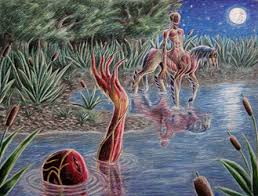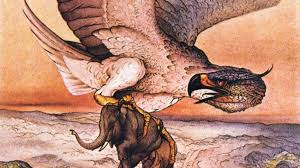Mythical Monsters: The Nuckelavee
Man it seems, but man it is not– nor beast nor any living thing Beware the demon of the deep when the fatal bell doth ring

Scottish mythology is a rich menagerie of supernatural creatures: the Sidhe, Tuatha De Danann, Fomorians, kelpies, and selkies all make up a rich, ancient civilization often hidden from human eyes, the politics and intrigues of which can have disastrous consequences when they spill over into the mortal realm. None, however, is more dangerous than the nuckelavee, a breed of demon so foul that a prayer must be said thrice before daring to so much as whisper its name. Some say they are mutated or elder kelpies; others claim that they are the mounts of the Four Horsemen of the Apocalypse, bringing death and destruction wherever they ride. Whatever their true nature, descriptions of the beasts remain fairly consistent. The most detailed account is given by Tammas, a peasant from the Orkney islands and one of the rare few who survived an encounter with one. It took Walter Traill Dennison, a famed folklorist of the 19th century, several months of harassing for Tammas to give his account; even then, the poor man was so utterly terrified he could hardly speak.
According to Tammas, the nuckelavee appears as a horse with a man’s torso sprouting from its back where a rider would be sitting. The arms of this torso have knobby, clawed fingers the length of a human’s calf, which brush the ground as it walks. The head of the man is huge and lolling, sporting a single eye “the color of congealed blood and burning like hellfire.” The equine head has “a muzzle sharpened like a beak, full of teeth like thorns or knives.” The teeth aren’t the primary hazard, however: the horse head spews a toxic, sulfurous vapor with every breath, capable of withering plants within a 20-foot radius and killing anything that breathes it. By far, the most disturbing aspect of the nuckelavee’s appearance is its lack of skin: you can watch its glistening muscles stretch and contract, its pulsating organs, and the black blood oozing through its yellow veins. The need for a heart would imply that the demon can be slain, although nobody has ever tried; to do so would require passing through the noxious cloud of gas, which has a 100% fatality rate despite the use of preventative measures such as masks and even priestly blessings.
Fortunately, the nuckelavee population is not a constant threat to mankind; during the summer months, the Mither of the Sea, an Orcadian goddess, keeps the beasts stabled in the oceanic abyss. Luckily, they are not herd animals as are horses, and being quite territorial, it is exceedingly rare to see more than one in the same area. There is one tried-and-true method of evading its pursuit: being bound to the sea, a nuckelavee cannot cross fresh water, a stipulation that holds true for most higher demons. It was by plunging into the Burn of Ayreland that Tammas escaped; sodden and shivering on the other side, he was paralyzed by fear as the enraged nuckelavee roared on the opposite bank. It made several false starts as though it would dive into the steam, but ultimately gave up and galloped away. Tammas developed a phobia of land, choosing to live almost exclusively in his tiny fishing rig. For this reason, he was considered mad by his fellow islanders, but Dennison saw a story where others saw only the ravings of a paranoid lunatic. Aside from his odd living habits and the occasional raving at a plough horse, Dennison eventually determined that the old man was quite mentally sound—concluding, naturally, that the creature he so feared had to exist. If you ever take a trip to the Scottish coast, you would do well to remember the location of nearby rivers and streams, pray to the Sea Mither for protection, and never speak the name of the dreaded nuckelavee aloud.







